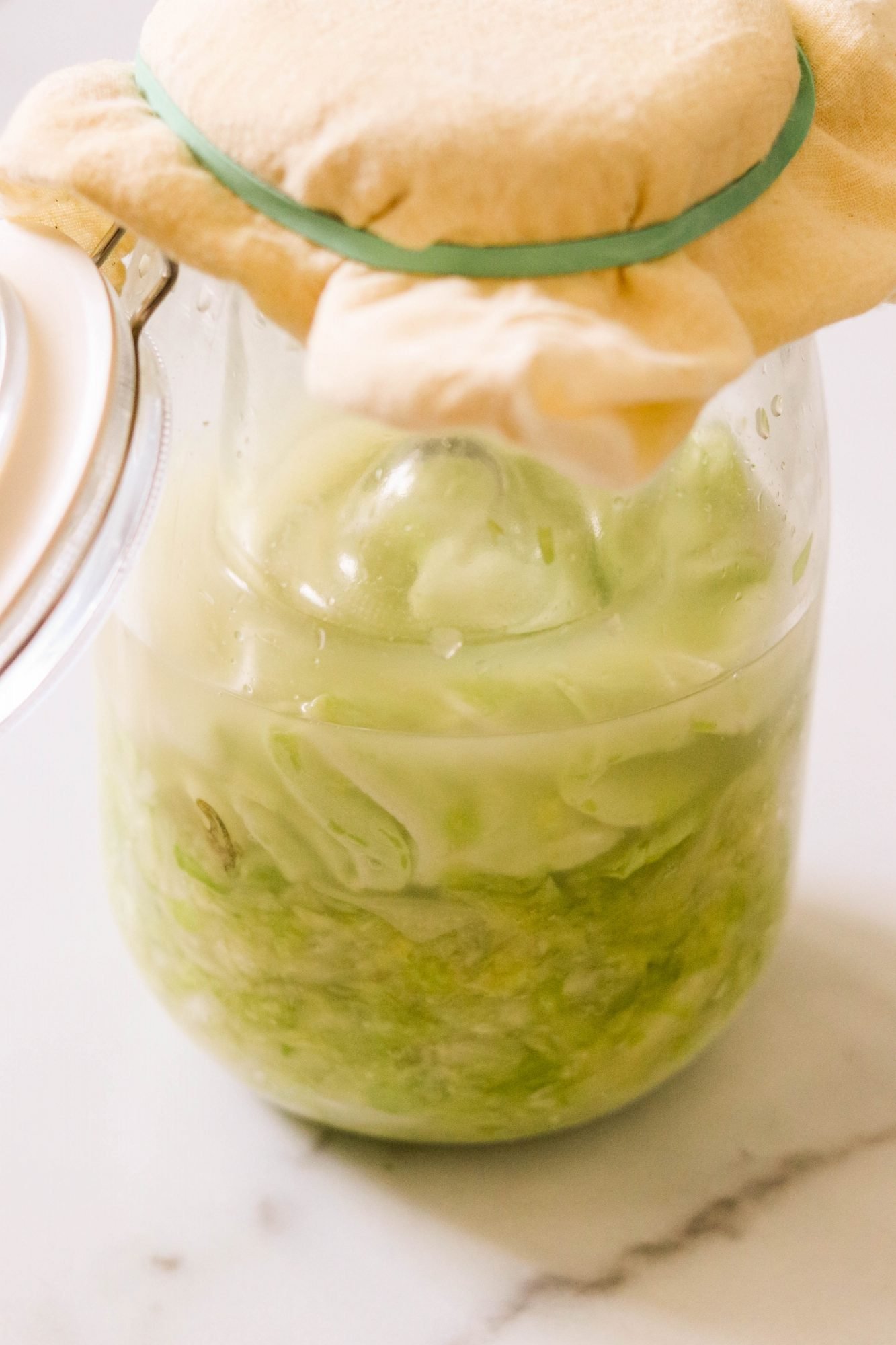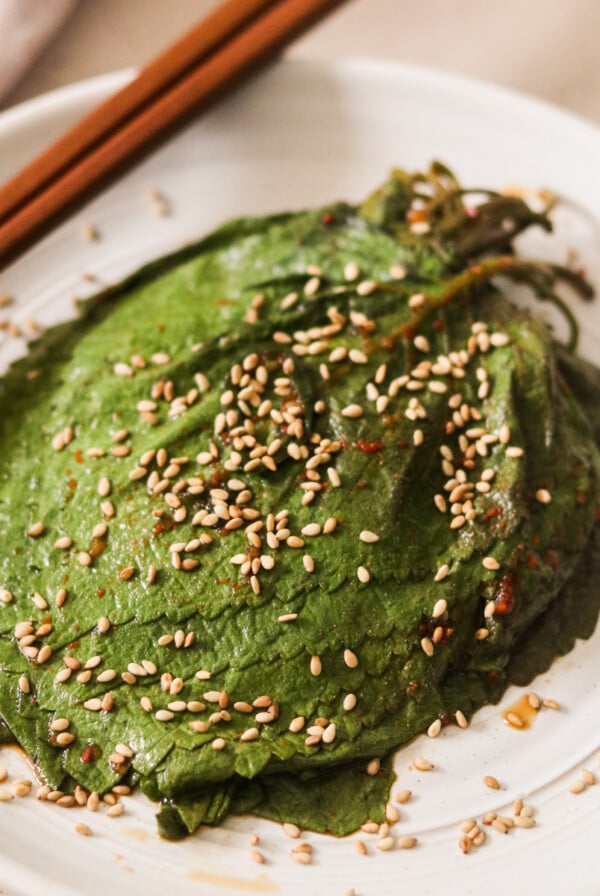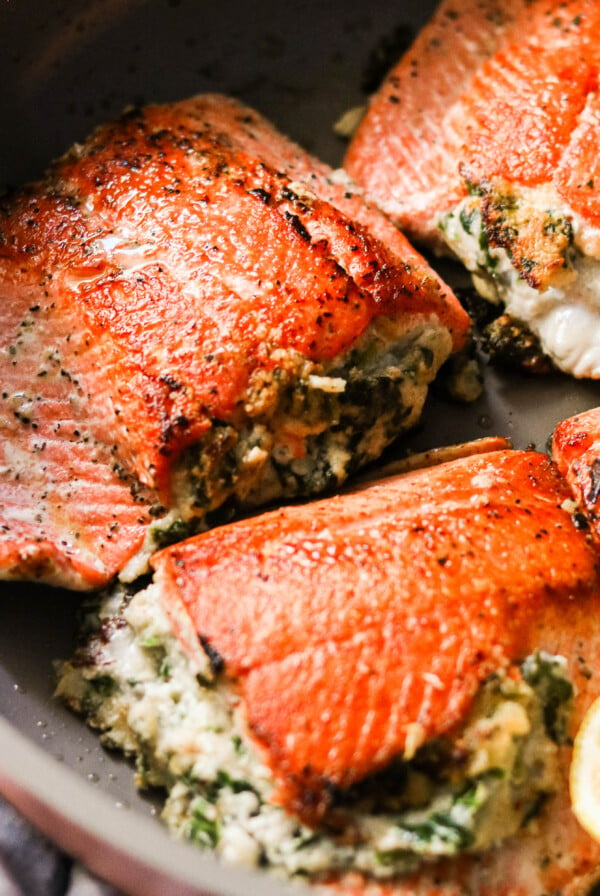This post may contain affiliate links. Please see our disclosure policy.

Why You’ll Love This Easy Mason Jar Sauerkraut
This simple, two-ingredient sauerkraut proves that fermentation doesn’t need to be complicated. Whether you’re brand new to fermenting or you’ve been making kombucha and kimchi for years, homemade sauerkraut is approachable, rewarding, and one of the best introductions to easy fermented vegetables.
I’ve struggled with digestive issues for years, and fermented foods like kombucha, kimchi, kefir, and sauerkraut have helped me tremendously. While probiotic supplements can be useful, foods like lacto-fermented sauerkraut offer a wider variety of probiotic strains that are better absorbed by the body. If you love exploring quick ferments, you might also like my baby bok choy kimchi, which has a similar tangy crunch
What I especially love about making sauerkraut in a mason jar is its versatility. It’s mild enough to go with almost any savory dish, from hearty German sauerkraut classics to fresh salads. And while the science of fermentation sounds intimidating, this small batch sauerkraut is as easy as massaging cabbage with salt until it creates its own brine. The crunch and tang that develop over time are worth every minute of patience.
Ingredients You’ll Need
- Cabbage: Green cabbage is traditional, but red cabbage sauerkraut adds a vibrant color and slightly sweeter flavor.
- Sea Salt: Helps draw out water from the cabbage, creating the brine for fermentation.
This really is a simple sauerkraut recipe – just two ingredients and basic equipment. If you’d like, you can also add flavor enhancers such as caraway seeds or juniper berries for a more traditional German sauerkraut recipe.
How to Make This Easy Sauerkraut Recipe

Step 1: Wash and quarter the cabbage, removing the core. Slice thinly, about 1/8 inch thick.
Step 2: Place the cabbage in a large bowl. Sprinkle with sea salt. Massage and squeeze the cabbage for about 15 minutes, until it wilts and releases its liquid. The cabbage should look soft and juicy.
Step 3: Pack the cabbage into a mason jar a few handfuls at a time, pressing it down with your fist or a spoon. Leave about 2 inches of headspace.
Step 4: Pour any liquid from the bowl into the jar to cover the cabbage. Place one of the reserved outer leaves on top to keep everything submerged.

Step 5: Add a smaller jar or glass weight inside to press the cabbage down under the brine.
Step 6: Cover the opening with cheesecloth and secure with a rubber band. Store at room temperature, away from direct sunlight.

Step 7: Ferment for 7-14 days. Check daily to ensure the cabbage stays submerged. Bubbles and foam are normal. Taste after one week, and when it’s tangy enough for you, transfer to the fridge.
Tips for Success + Troubleshooting
- Keep it crunchy: Always keep cabbage under the liquid brine. Exposure to air can cause spoilage or mushiness.
- Mold prevention: A little surface yeast is harmless, but visible mold means you should start again. Clean equipment and full submersion help.
- Salt matters: Use non-iodized salt like sea salt or kosher salt. Iodine can interfere with fermentation.
- When is it ready? Your raw sauerkraut should taste tangy, slightly sour, and pleasantly crunchy. Start tasting after 7 days, but ferment up to 4 weeks for stronger flavor.

Cabbage Fermentation Guide
Making sauerkraut is one of the simplest forms of cabbage fermentation, and it follows the same principles used for many fermented vegetables. Salt draws out liquid to form a natural brine, while good bacteria thrive in this oxygen-free environment. This process creates a raw probiotic sauerkraut that supports gut health and immunity.

Storage & Creative Uses
Once your fermented cabbage recipe tastes right to you, move it to the fridge where it keeps for several months. The flavor will continue to deepen while staying crisp.
Beyond topping sandwiches and sausages, sauerkraut pairs beautifully with roasted meats, grain bowls, and even fresh salads like my paleo beet salad with cabbage and pecans.
And don’t forget the brine – try these 9 ways to use sauerkraut juice. It’s full of natural probiotics and can even kick-start other ferments like beet kvass!
Recipe FAQs
Usually 7-14 days at room temperature. Taste after a week. When it’s tangy enough, transfer to the fridge.
No. A clean jar, salt, and cabbage are all you need. A small jar as a weight helps, but no crocks or airlocks required.
Stored in the refrigerator, homemade sauerkraut keeps for months. The flavor develops but remains crisp.
Yes! This two-ingredient sauerkraut is naturally vegan, paleo-friendly, Whole30-compliant, and gluten-free – perfect for most dietary lifestyles.
This mason jar sauerkraut recipe shows how easy it is to turn cabbage and salt into a jar of tangy, crunchy, gut-friendly goodness. It’s one of the most rewarding kitchen projects you can take on, rooted in centuries-old tradition from Germany to Eastern Europe, and still loved today for its flavor and health benefits.
More Fermented & Flavorful Sides You’ll Love
If you make homemade sauerkraut recipe, please leave me a star rating and comment below! I love to hear your thoughts and feedback. Follow me on social media Instagram, Facebook, and Pinterest, for even more delicious recipes!

Easy Sauerkraut Recipe (2 Ingredients)
Ingredients
- 1 medium head of cabbage
- 4 tsp sea salt
- 2 qt clean mason jar
- glass jar small enough fit in the mason jar
Instructions
- Wash the cabbage. Remove the large outer leaf and set aside.
- Quarter the cabbage and remove the core. Cut each quarter into thin slices down its length, about 1/8 inch thick.
- Place the cabbage slices in a large bowl. Sprinkle with salt.
- Mix, squeeze, and massage the cabbage for about 15 minutes, wearing gloves if needed. The cabbage slices will wilt and release liquid, and will look juicy at the end.
- Place the cabbage slices into the mason jar by a couple handfuls, packing it down every so often with your fist or a spoon. Leave at least 2 inches of room from the top.
- Pour any cabbage liquid from the bowl into the jar.
- Place an outer leaf you had set aside flat on top of the sliced cabbage to help keep everything under the liquid.
- Add a small jar inside the mason jar, pushing it down on top of the cabbage to weigh it down and submerge in liquid.
- Cover the jar with a cheesecloth and seal the opening with a rubber band. This will ensure that the cabbage breathes without being sealed air-tight.
- Store at room temperature away from sunlight. As the cabbage ferments, check to see that the cabbage stays under the liquid, and push down the jar inside if you see it rising. Also, the liquid may bubble and foam at the top. It may even rise and spill out. This is all completely normal.
- Start tasting after 7 days. Ferment longer if it needed. When it's tangy enough to your liking, store in the refrigerator. It will keep for months.
Notes
- Keep it crunchy: Always keep cabbage under the liquid brine. Exposure to air can cause spoilage or mushiness.
- Mold prevention: A little surface yeast is harmless, but visible mold means you should start again. Clean equipment and full submersion help.
- Salt matters: Use non-iodized salt like sea salt or kosher salt. Iodine can interfere with fermentation.
- When is it ready? Your raw sauerkraut should taste tangy, slightly sour, and pleasantly crunchy. Start tasting after 7 days, but ferment up to 4 weeks for stronger flavor.
- Once your fermented cabbage recipe tastes right to you, move it to the fridge where it keeps for several months. The flavor will continue to deepen while staying crisp.
Regarding other affiliate links and affiliate relationships: In order for me to support my blogging activities, I may receive monetary compensation or other types of remuneration for my endorsement, recommendation, testimonial and/or link to any products or services from this blog. Thank you for your support and understanding.










Excellent recipe. Easy to prepare and you answered all my questions in your write up. Thanks very much!
Was so easy! Two weeks and was perfect! I did add one tablespoon of caraway seeds…😊👍
Yay! So glad you enjoyed it!!
Your saurkraut recipe sounds great! I will definitely try it. I love saurkraut.
Enjoy!
The above recipe looks really good. It looks like a lot of steps but is really quite easy. You can probably useess salt as long the temperature is about 68 degrees and everything stays submerged.
1 tsp of salt per cup of water works well if more is needed.
The red cabbage kraut is really good and seems a bit firmer/crunchier to me than green. Also I have noticed that adding caraway seeds adds a whole new level of flavor.
I notice with this last batch I have made I do not have enough juice. Can I make up a mix of salt water to add?
Yes, that will work.
Thank you so much! When I’m lazy and I’m not making it at home, your brand is my go-to. Love me all the probiotics!
Thank you for the easy recipe! I made a batch last week for the first time, and I just tasted it, it’s supe salty, how can I adjust that?
Best,
S. M
You can try adding more cabbage to the current batch and mixing together, then ferment again. The fermentation shouldn’t take as long for this round.